How to Make Biodiesel
Overview
Biodiesel can me made by nearly anyone in a simple process that is often compared to brewing beer. For this reason it is possible for nearly anyone to take control of their own energy independence by making their own fuel.
It is made by a chemical reaction known as transesterification, which involves replacing the glycerol component of an oil with an alcohol in the presence of a catalyst. There are three primary ingredients needed:
Ingredients
The primary component for making biodiesel is an oil or fat. For homebrewers this is commonly waste vegetable oil, which is ususally available for free from local restaurants. Farmers in the United States often use virgin vegetable oil grown from canola or soybeans. It should be obvious that farmers can grown their own feedstock to run tractors and other equipment offering them true energy independence. Larger scale producers may use recycled cooking oil, virgin oil, as well as animal fats, algae, fish oils, trap grease and many other types of oils or fats. Indeed one of the beauties of making biodiesel is the wide variety of choices in the ingredients that can be used.
The second ingredient is a type of alcohol. When using recycled vegetable oil, the most common choice is Methanol or racing fuel, which is readily available for purchase throughout the country. When using virgin vegetable oil, it is often possible to use ethanol instead, however the ethanol cannot contain water and the vegetable oil needs to be dewatered and degummed. For doing test batches "Heet" brand gas antifreeze contains nearly 100% methanol.
The final ingredient is a catalyst. One option for a catalyst is Sodium Hydroxide (NAOH), which is available at local grocery and hardware stores as a drain cleaner. The most common brand is "Red Devil Lye". Another option is Potassium Hydroxide (KOH). One advantage to using potassium hydroxide as a catalyst is that the glycerine by-product from the chemical reaction will be far less toxic than when using sodium hydroxide. Many people find it is possible to compost their glycerine by-product when using KOH as a catalyst.
Oil Collection
While it is possible to make biodiesel out of many different types of oil, by far the most popular type of oil used by small scale producers is used cooking oil. Restaurants normally have to pay grease collection companies to have their used cooking oil hauled away. For this reason, it is normally fairly easy to make arrangements with restaurants to let you take their used oil for free.
The best method is to arrange with the restaurants to pour their cooking oil back into the containers it arrived in. Normally five gallon carboys, surrounded by cardboard as shown in the photo. This way the oil is not exposed to water, dirt and other contaminants as it can be in an outdoors grease dumpster or barrel. Also, once the oil is placed in the grease collection barrel or dumpster it often times becomes the property of the grease collection company.
If a restaurant does not want to put the oil back into the original containers, they will often allow you to supply your own barrel. Then you can simply pump the oil out of that barrel into another container, or switch and empty barrel for the full one.
Oil Quality
The cleaner and newer the cooking oil, the easier it is to make quality biodiesel. Generally the lighter the color and the clearer the oil, the better. Be careful of oil that is very dark or oil that looks like it has a lot of extra particulate immersed in the oil. Watch out for oil that smells bad. The oil should smell like cooking oil and not have a spoiled, bacteria type of smell. If you are unsure if the oil is good, the best bet is to take a half gallon sample. Run a titration on the oil and make a small test batch. Then if you get good fuel, you can be more confident in collecting larger amounts of oil and making full size batches of fuel with it.
Titration
When making biodiesel out of used oil or grease, it is important to determine the free fatty acid content. This is because the amount of catalyst used in the biodiesel reaction is determined by the amount of free fatty acids present in the oil or grease. The way to determine this is through a process known as titration.
The procedure is straightforward:
1. Dissolve 1 gram of catalyst (either Lye or Potassium Hyrdroxide) in one liter of distilled water.
2. Measure out 10ml of isopropyl alcohol (90% or better) into a small container.
3. Mix in 1ml of the oil to be tested with the alcohol. Make sure it mixes thoroughly.
4. Mix in 2-3 drops of PH indicator solution (phenolphtaleine or phenol red).
5. Start adding water/catalyst solution to mixture while stirring. Measure how much solution is required to bring the solution to a stable violet or pink color (approximately PH 8.5). Keep track of how many milliliters were used.
That's it!
If the oil required less than 3ml of solution, it is probably very good oil. If it required 3-6 ml it is most likely adequate oil for making biodiesel. Anything over 6ml is not very good oil, but it may still be possible to use this oil to make high quality fuel.
Regardless of your titration results, it is highly recommended to make a 1 liter test batch of fuel before proceeding to the full size batches.
Test Batches
It's always a good idea to make small test batches of biodiesel before making a full batch. It's especially important to make test batches when dealing with any new sources of oil, questionable oil, or if you're not absolutely sure of your titration results. This way, any problems are limited to a quart or a liter as opposed to 20 or 40 gallons.
Luckily it's quite easy to make a 1 liter test batch of biodiesel. Start by heating up 1 liter of oil to 120F. In a separate leak proof container, mix together 220 ml of methanol with the amount of potassium hydroxide or sodium hydroxide determined by your titration.
If using Potassium Hydroxide: New Oil - 7 grams, Used Oil - 7 grams + 1 gram for every milliliter of catalyst/water solution needed in titration. For example if your titration used 3.5 ml, then you would use 7 + 3.5 = 10.5 grams of pottasium hydroxide.
If using Sodium Hydroxide: New Oil - 5 grams, Used Oil - 5 grams + 1 gram for every milliliter of catalyst used in titration. For example if your titration took 4 ml, then you would use 5 + 4 = 9 grams of sodium hydroxide.
Mix methoxide until all catalyst is dissolved, then carefully pour into oil. Make sure container is completely leakproof, then mix together for 10-15 minutes.
Allow to settle for 1 - 8 hours.
Success: Clear separation between the biodiesel and the glycerol, two distinct layers. At least 10% glycerol by volume.
Problems:
1. Less than 10% glycerol - Most likely did not use enough catalyst. Try again adding more catalyst.
2. Significant layer of soap between biodiesel and glycerol - Indicates too much catalyst was used. Try again with less catalyst.
3. Glop - Could indicate bad oil or incorrect titration. Redo test batch, if you get glop again, consider not using that oil source.
Caution: Methanol, Methoxide (Methanol mixed with catalyst), Lye and Potassium Hydroxide are all dangerous chemicals. Read MSDS sheets before using. Work in well ventilated area and always wear protective clothing, goggles eyeware and mask when dealing with these chemicals.
Full Size Batches
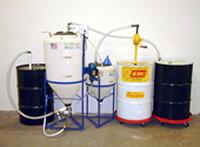 |
The FuelMeister™
and FuelMeister
Plus™ processing systems are capable of making batches
of biodiesel from 1 to 42 gallons at a time. The system is
designed to be as automated and simple as possible. Almost
anyone can learn to make their own biodiesel with a FuelMeister.
Note: This is meant as an overview, please read your
FuelMeister manually carefully and be sure you understand
the whole procedure before attempting to make your own fuel.
|
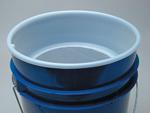 |
1. Filter
40 gallons of oil to about 200 microns, then pour or pump into
oil
preheating unit. |
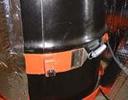 |
2. Heat oil to 120 degrees fahrenheit. |
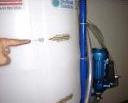 |
3. Draw oil into the processing unit and
recirculate to get good oil mixture for titration sample. |
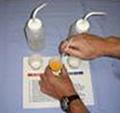 |
4. Perform titration
to determine amount of catalyst needed. |
| 5. Use the calculator below to determine
the amount of catalyst to use. |
| Titration Calculator |
|
|
This calculator will calculate how much
catalyst to use for a given amount of oil.
Please enter information below.
1. Select Unit of Measure - Gallons or Liters
2. Select Catalyst type.
3. Enter how many gallons of fuel are you making.
4. Enter what your titration result were. (In millilters)
5. Select "Calculate Catalyst". Select "Reset"
to clear all values.
|
|
|
|
|
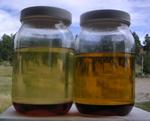
|
6. If this is a new oil source or you have any doubts
about the oil or your titration results, make a 1 liter test
batch of fuel.
|
 |
7. Measure catalyst and pour into premix
tank. |
 |
8. Pump 8.8 gallons of methanol into premix
tank. |
 |
9. Mix oil with methoxide (methanol/catalyst
mix) for 1 hour. |
 |
10. After 1 -2 hours drain glycerol off
bottom of processor. Let sit for 8 hours and drain balance of
glycerol off. |
| Caution:
Methanol, Methoxide (Methanol mixed with catalyst), Lye and
Potassium Hydroxide are all dangerous chemicals. Read MSDS sheets
before using. Work in well ventilated area and always wear protective
clothing, goggles eyeware and mask when dealing with these chemicals. |
Washing
Water washing biodiesel is very important to to remove contaminants, which could otherwise damage engines or fuel injector pumps. Washing removes soap, excess methanol, particulates and any other water soluble particulates in our fuel.
The FuelMeister™ and FuelMeister Plus™ both come with a built in water misting system.
1. Hook a water hose onto the input side of the FuelMeister processing system, and turn on for 1 to 2 hours. This will mist about 5 to 10 gallons of water through the fuel. The water is heavier than the fuel, so it will pass through the fuel, removing contaminants as it flows to the bottom of the tank.
Note: Warm water will work better than cold water and soft water works better than hard water. If you are having mist washing problems, consider adding a heater or a water softener to your wash water.
2. Let sit for 1 hour or more to allow the surface contact with the water to remove contaminants from the fuel.
3. Drain water from bottom of tank.
4. Repeat at least two more times until drain water is coming out fairly clean.
5. Once the bulk of the soap has been removed along with the methanol and particulates. Finish getting the last of the soap out of your fuel with a bubble washer.
6. Heat tank to about 90°F, add about 5 gallons of water, turn on bubble washer and allow tank to bubble wash for 2 - 8 hours.
7. Drain soapy water and repeat until water being drained out is as clean as the water being added to the tank.
8. Once the fuel has been washed, there will still be a very small amount of water suspended in the biodiesel. The fuel will not be clear because of this water. The last step is to either open the cover of the FuelMeister or pump the fuel into an open top container. Then let the fuel be exposed to air for a few days until all the water evaporates from the biodiesel. The fuel will take on a clear appearance and you should be able to look through a small container of the fuel and read newsprint on the other side.
Quality Control
One of the most important aspects of brewing biodiesel is making sure you have quality fuel before running it in your diesel engine. Bad quality fuel can damage key engine components and cause breakdowns. Luckily it's fairly easy to make sure you are making good quality biodiesel.
The most important part of quality control, is making sure your reaction went properly in the first place. Try to start with the best quality oil you can find, do careful and accurate titrations and monitor your reaction. Make sure you get 2 distinct layers, one of glycerine and one of biodiesel. Make sure you drained at least 10% glycerine off the bottom of your fuel. Wash your fuel thoroughly until the water coming out looks like the water going in and you can see no soap in the fuel. Let your finished fuel be exposed to air for several days until suspended water particles evaporate and your fuel is clear. Once you are sure all of these steps were followed, it is time to test your fuel for quality.
Test #1 - Clarity
Take an approximately 500ml sample of your fuel in a clear container. You should be able to read newsprint through it. If you cannot see through the fuel it's an indication there may still be water, glycerine, monoglycerides or diglycerides in your fuel. You don't want any of these in your finished fuel.
Test #2 Miscibility
Using your 500ml sample, mix in about 1 cup of water. Shake until water mixes with the fuel. Let sit for a few minutes. The fuel should separate from the water and there should be no layer of soap between the two layers. If soap is created, it's an indication further washing is needed. If the fuel does not separate easily, it's an indication of poor quality fuel.
Test #3 Odor
Smell the fuel, it should have a faint odor of vegetable oil with no alcohol type smell.
Other Tests
If your reaction went according to plan, and the biodiesel passed the three tests shown above, you can be confident you have good fuel. However it is possible to run other tests to be sure. You can test the PH of the fuel exactly the way you titrated your original oil. Good bioidesel should have a PH of around 7. You can test the specific gravity of the fuel with a hydrometer, or you can even send the fuel out to a lab and have it tested to see if it meets ASTM D6751 specifications. Generally these tests cost approximately $100 one such lab is Caleb Brett
Emulsion Issues
Emulsions occur when water becomes mixed with the fuel during a water wash and will not separate. The result looks like a coffee milkshake. Biodiesel emulsions occur most commonly when fuel with a lot of soap in it is washed to vigorously. This is one of the reasons we recommend mist washing followed by bubble washing. You are less likely to get an emulsion with a light mist than with bubble washing.
The best policy is to avoid emulsions by carefully washing your fuel and always doing accurate titrations to avoid excess soap in you fuel. However if you do get an emulsion there are ways to deal with it.
Emulsion Breaking
It is a good idea to save some glycerine you have previously drained off biodiesel batches for breaking emulsions. Add 10% by volume glycerine into the emulsified biodiesel and mix. See if emulstion starts to break. If not add 10% more and mix. Repeat until emulsion breaks. When it does, glycerine will separate from biodiesel just like in a normal reaction. Drain off glycerine and wash as normal.
Ingredients & Supplies
Catalyst
Potassium Hydroxide
Sodium Hydroxide
Methanol
Methanol is a very common chemical and quite easy to come by. It comes in 3 grades - industrial grade, racing grade and chemical grade. The chemical grade and racing grade contain less water, which makes them preferable for producing biodiesel, but the industrial grade will work. From a price and quality perspective, racing grade methanol is the preferred grade to use. It is racing fuel and as such can be found at race tracks and high performance automotive stores. If you cannot find race grade methanol, look for "Oil Companies" in the yellow pages and you will usually be able to find places that carry industrial grade methanol quite easily in most locations. Here are some methanol distributors:
United States
Sunoco Race Fuels (many locations) Web: www.racegas.com
Turbo Blue Racing Gasolines (many locations) Web: www.turboblue.com
VP Racing Fuels, Inc. (many locations) Web: www.vpracingfuels.com
California
ERC Racing Fuels - 610 E. Llewelling Blvd, San Lorenzo, CA 94580
F and L Co., Inc. Long Beach, CA Web: www.racefuel.com
Colorado
Hill Petroleum - Denver, CO
Dial Oil - Pagosa Springs, CO
Indiana
Competition Fuels, Inc. Indianapolis, IN Web: www.elffuel.com
Michigan
Torco Racing Fuels N. Decatur, MI Web: www.torcoracefuels.com
Minnesota
Koch Performance Racing Fuels Golden Valley, MN Web: www.racingfuels.com
Mississippi
Carr Oil Racing Fuels Tupelo, MS Web: www.carroilracingfuels.com
Ohio
Bazell Race Fuels - Logan, OH Web: www.bazellracefuels.com
Utah
Kemco Oil 1374 E. Main Lehi, UT 84043-9705 (801) 768-4408
Hi-Valley Chemical 1134 W 850 N Centerville, UT (801) 295-9591
Virginia
World Wide Racing Fuels New Canton, VA Web: www.worldwideracingfuels.com
Ethanol
If you are using virgin oil or oil that has been careful dewatered it is possible to use ethanol. Be sure to use a grade of ethanol that contains little to no water.
Bi-Products
There are two bi-products associated with making biodiesel, glycerol and soap.
Glycerol - The glycerol bi-product will contain the catalyst and about half the excess methanol from the reaction There are several options of dealing with this glycerol bi-product. When using Potassium Hydroxide (KOH) as a catalyst it is possible to use the glycerol to make fertilizer or to simply compost it.
When using Lye, which is Sodium Hydroxide (NAOH), it is possible to evaporate or boil off the methanol (be careful of the methanol fumes) and to quite easily turn the glycerol into soap.
Water - The water drained off the bottom of the biodiesel will contain soap and methanol. You can add acid to this water until the PH is neutral, then dispose of it down the sewer or in your yard.
Most people do not go to this much trouble, because small amounts of methanol and soap in the sewer are not generally thought to be a major problem and they simply dispose of the water as you would other soapy water.
This article originally appeared on Planet Biodiesel website. For more information about biodiesel, equipment and supplies, visit www.PlanetBiodiesel.com .
